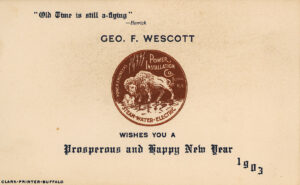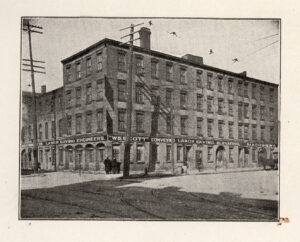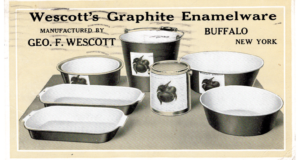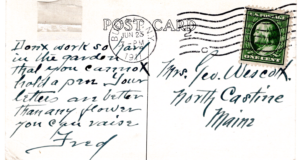Sales literature and a postcard in the Westcott Society Collection show some of the business ventures of one Geo. F. Wescott (1854-1913) while he was living in Buffalo, New York in the first decades of the 20th century: power installation; elevators, conveyor belts and other labor saving equipment; and graphite enamelware.
George Frederick Wescott was born in Castine, Maine on April 18, 1854, the first child of George and Mary (Avery) Wescott. According to one family tree, George was not a descendant of Stukely and Juliana Westcott, but in the line of Daniel Wescott, who appears to be in the second generation of Westcotts in America and whose relationship to Stukely needs to be resolved: George Frederick9 Wescott, George8, Joseph7, Joseph6, William5, Andrew4, Richard3, Daniel2, [original settler Wescott]1
George married Mary Ella Bent on October 3, 1878 in Portland, Maine, and the couple had four children: Otis Bent (1881-1931), Marion (1890-1910), Mae Ellen (1894-1980), and Dorothy (1895-1895). Sometime after Otis’ birth the family moved to Minnesota, a common migration path for Maine Wescotts, but at the end of the century they headed east and by 1899, they were set up in Buffalo, where George was chief engineer for the Power Installation Company (and a “soliciting partner” in the Jeffrey Manufacturing Company). In 1907 the George F. Wescott Company was in its own building on the corner of Perry and Washington Streets. Signs on the building announced Geo. F. Wescott Co. Labor Saving Engineers and “Wescott” Conveying, Labor Saving, Elevating Machinery. In the following year, the Buffalo City Directory lists son Otis as the chief engineer of the “elevating and conveying machinery” company.
Somewhere along the line, George developed a line of enamel cookware, which was manufactured by an Ohio company and marketed to food processing companies. Wescott’s Enameled Steel Ware was coated with artificial graphite developed by Edward Acheson, the inventor of carborundum. In the mid 1890s, Acheson discovered that overheating carborundum produced almost pure graphite. In addition to selling “Wescott’s Enameled Steel Ware,” George sold graphite in liquid form so that users could re-coat the cookware annually.
In 1912 or 1913, George moved back to New England leaving his son Otis and daughter Mae Ellen to run the company. In 1918, The George F. Wescott Company was controlled by other Buffalo business interests. George died on April 23, 1913. He is buried in South Paris, Maine.
Sources: Ancestry.com and Family Search for U.S. City Directories and state and Federal census records.
Juneanne Wescoat Glick, Westcote (Clayton, New Jersey: Bregler Associates, 1991) provides information on the Maine Wescotts and other distant cousins. A copy of the book is in the Westcott Society Collection in Narragansett, R.I.




